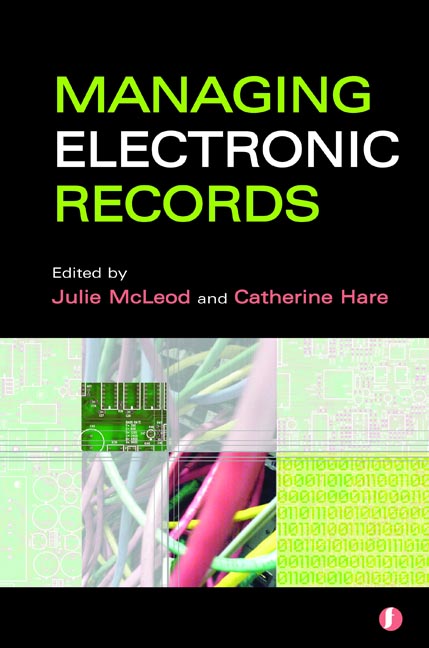Book contents
- Frontmatter
- Contents
- The editors and contributors
- Preface
- 1 The wild frontier ten years on
- 2 The use of standards and models
- 3 Metadata matters
- 4 Digital preservation – ‘the beautiful promise’
- 5 Research in electronic records management
- 6 Technologies for preservation
- 7 Legal issues
- 8 Ethics and electronic recordmaking
- 9 Competencies – the asset that counts most: on developing human talents as a prerequisite for successful EDRM changes
- 10 Records management: two case studies from the French private sector
- 11 Implementing a solution for electronic recordkeeping in the public sector
- 12 Playing the long game – creating and maintaining the links in the value chain
- Index
12 - Playing the long game – creating and maintaining the links in the value chain
Published online by Cambridge University Press: 08 June 2018
- Frontmatter
- Contents
- The editors and contributors
- Preface
- 1 The wild frontier ten years on
- 2 The use of standards and models
- 3 Metadata matters
- 4 Digital preservation – ‘the beautiful promise’
- 5 Research in electronic records management
- 6 Technologies for preservation
- 7 Legal issues
- 8 Ethics and electronic recordmaking
- 9 Competencies – the asset that counts most: on developing human talents as a prerequisite for successful EDRM changes
- 10 Records management: two case studies from the French private sector
- 11 Implementing a solution for electronic recordkeeping in the public sector
- 12 Playing the long game – creating and maintaining the links in the value chain
- Index
Summary
Introduction
Much has been written about the challenges of managing electronic records and the chapters in this book have aimed to address them. The nature of the records themselves and the tools to manage them present three challenges. First, in managing e-records we are dealing with objects that are intangible, whose value is not always acknowledged, and in an environment that is virtual and dynamic. Second, the tools we use are dynamic and constantly evolving as indeed are the solutions. And third, the tools themselves at best do not give priority to recordkeeping and at worst create nightmares for records managers. ‘Deleted’ records that remain recoverable and storage media that survive but become inaccessible, because the hardware and software to read them have disappeared, are but two examples.
We are, therefore, faced not only with keeping pace with new ICTs and learning how to use them but also with understanding their implications for and impact on recordkeeping. A danger in this dynamic environment is to focus on the tools rather than what they are creating and what needs to be managed and, in the process, losing sight of where we are trying to get to, indeed of where we need to be. We could address the immediate management problems with an IT solution by implementing a software tool. However, since information is the lifeblood of many organizations we must ensure we do not lose the value of the information that is contained in records and add value by managing and exploiting it. How can we achieve this?
The case studies presented by Judith Ellis and Pierre Fuzeau demonstrate that there is no single best solution, one size does not fit all. What they do show is that records management is a management activity and, like all management activities, the approach needs to address the strategic, tactical and operational levels. The contributors to this book have offered frameworks, advice and guidance that address all three levels.
As well as needing to cover these three levels, the successful management of e-records is not something that can be achieved overnight in the form of a once and for all solution. This is the long game.
- Type
- Chapter
- Information
- Managing Electronic Records , pp. 186 - 194Publisher: FacetPrint publication year: 2005

